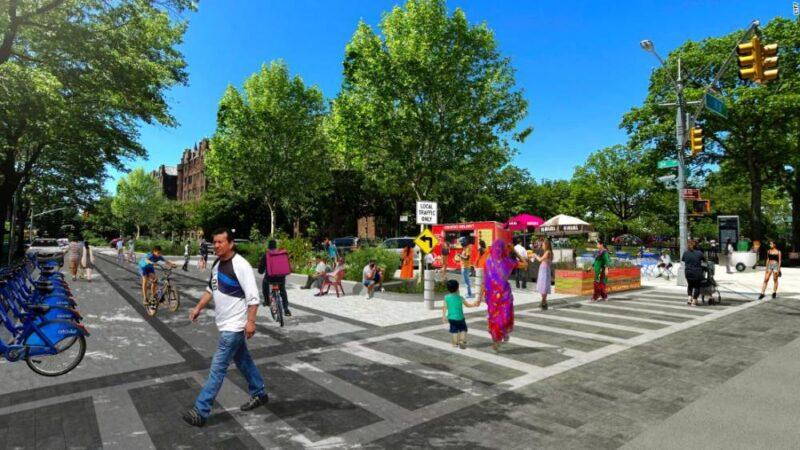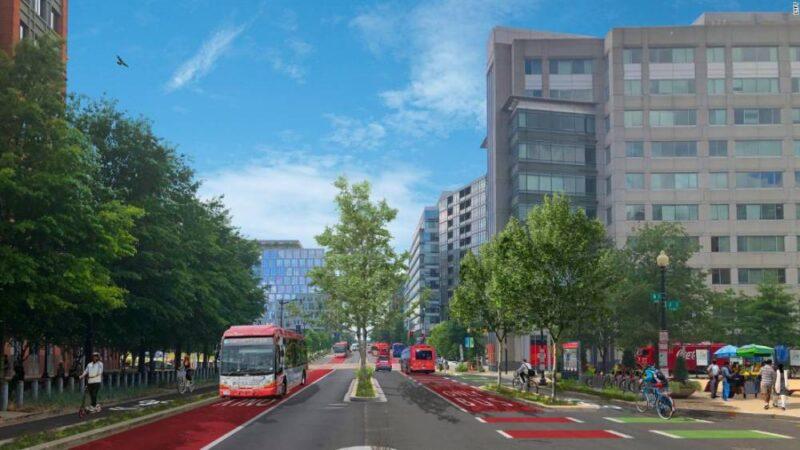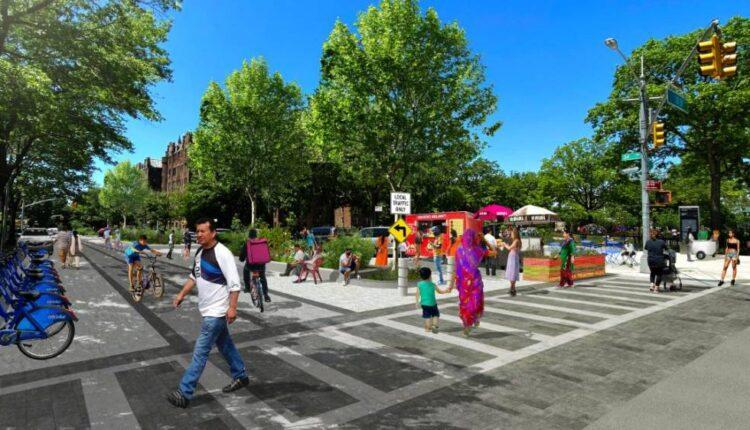Washington, DC (CNN)As Lyft’s core ridehail business is pummeled by the pandemic, the company has taken a seemingly surprising step, paying urban planners to sketch out how street space can be shifted from cars to buses, bikes and pedestrians.
Lyft released case studies Friday for what it calls resilient streets, which cater to multimodal commuting, in which people rely on several different ways of getting around. The plans detail how streets in Chicago, New York City and Washington, DC could have wider sidewalks, plus more bus and bike lanes. Some of the plans include details that would clearly benefit Lyft, such as adding more of its bikeshare stations and lanes for those bikes to ride in. (Lyft operates bikeshare systems in all three cities and scooters in Washington, DC.)
Caroline Samponaro, who leads micromobility policy at Lyft (LYFT) , told CNN Business that the company was motivated by steps cities have taken during the pandemic to embrace car alternatives, as well as by concerns that cities will revert to their car-centric ways. Many cities have temporally closed streets or added bike lanes and outdoor dining spaces.”We’ve spent the last couple decades trying to dig ourselves out of the mess of building our transportation systems around single occupancy vehicles,” Samponaro said. “We don’t want overnight for us to go backwards there.”Read More

This rendering from Lyft shows how city streets could be redesigned to cater to modes other than cars.Samponaro pointed to people in some cases gravitating to cars amid concerns about transit and social distancing. Used car sales have grown this year. She said the design of streets signal to people how they should get around, and what options they have. With more transit, bike and walking infrastructure, people are less likely to rely on cars. Samponaro declined to say if the plans would have any adverse impact on Lyft’s core business, and said that streets are currently an underutilized resource with little done to make them sustainable or efficient. Lyft wants to make cities more effective and efficient, she said.Transportation and planning experts welcomed Lyft’s proposals. Robin Chase, who founded Zipcar and now leads the New Urban Mobility alliance, said that Lyft’s concepts would benefit the company, despite taking space away from cars that make up most of its business right now.”It’s self-serving and it’s also correct,” Chase said. “It’s high time for cities to start promoting true multi-modalism.”With multimodal transportation there’s less need to own a car, Chase said, making residents more likely to use Lyft’s services, which include shared bikes and scooters, rather than defaulting to personal cars. “Those of us in the business, we know cities need to reallocate space away from single occupancy vehicles,” said Gabe Klein, a partner at the city planning group CityFi, who previously led transportation departments in Chicago and Washington, DC. “This amplifies a very positive message.”This isn’t the first time Lyft has spoken out about redesigning streets. In 2017, it presented a concept for how Wilshire Boulevard in Los Angeles could be redesigned. With its new projects, the company has gone a step further by connecting with local advocates who were already calling for what Lyft has proposed.

This rendering from Lyft shows how M Street in Southwest Washington, DC could be redesigned to cater to modes other than cars.Greg Billing, executive director of the Washington Area Bicyclist Association, said it’s helpful to have voices like Lyft involved. “We need to make our transportation system work and safe for people who need to get around,” he said.One of Lyft’s case studies suggests building bus and bike lanes on M Street in Southwest Washington, DC, a broad street that caters to many lanes of car traffic.
Bill Schultheiss, vice president of the urban planning group Toole Design, said he’s excited by the proposal. It resembles a plan he proposed 10 years ago that never came to fruition. “Back then I knew it was a long shot, and today this feels realistic,” Schultheiss said. “That tells you how much the mindset of everybody involved has changed.”
Source: edition.cnn.com

